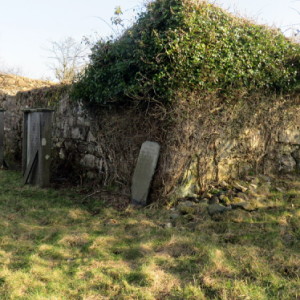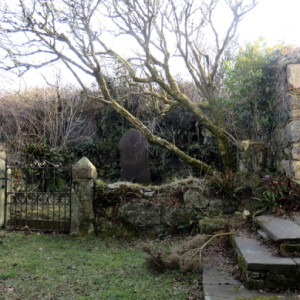Salem above the sea
It was hard to pick a blip from today's crop of images but this one, the view from, rather than of, the derelict chapel, appeals to me for the way in which the the stained slate grave markers are matched in colour by the lichen-encrusted thorn bush, its grizzled inflorescence nurtured by the purity of the clear cold air blowing in across this rugged peninsula.
Years ago when I came across the unremarkable roadside cottage whose chimneys you can see here ( the Irish ferry at the start of its four-hour crossing to Rosslare visible between them), the name of the dwelling caught my interest - Salem, often used for non-conformist chapels. None was marked on the map here, nor evident from the road - but I peeked behind the cottage and found an overgrown graveyard and behind it a tiny ruined building but all so wreathed in brambles that exploration proved impossible. I remained curious but never found out any more.
Until recently. A friend who's also keen on local history alerted me to the fact that there had been new developments, and that not only had the old chapel and its graveyard been revealed but also some its history, in the publication online of the diary of the gentleman-farmer who was responsible for the building the chapel in the mid-19th century. We came out here to have a look.
John James was born at the adjacent family farm, Trenewydd, in 1814. It was a large holding for the area and had been one of the farms briefly overrun by the French soldiers who landed on the coast in 1797. By the time he was 32 John's parents had died and he was in charge. He married a local girl, had three children and prospered, managing the 150 acres with the help of hired labourers, house servants and a governess for the children. He became a Justice of the Peace and donated a plot of land for a temperance hotel in Fishguard (now the cinema.) It has to be assumed that John James it was who provided the land and funds for foundation of Salem chapel. Remote though it is, on a single track road that leads to the lighthouse and nowhere else, it would in its day have been a very welcome centre of worship and social gathering for local families who would otherwise have to travel some way.
The chapel was partially dismantled in the 1960s, by then having fallen into disuse what with population change and motor transport.. The first extra image shows what little remains of it , viewable now thanks to the efforts of the new owners of the cottage on whose property it stands.
The tiny graveyard has recently been cropped by sheep judging by the wisps of wool on the bushes and droppings among the graves but stunted primroses stud the ground nonetheless. The deceased all seem to belong to a few local families, chief among them being the James clan. John James himself lies in a small separate enclosure at the highest point, flanked by his wife Jane and youngest child David who died aged 7. Like many others here, his coffin-shaped resting place is marked by an outline of slate edging , the headstone being set slightly back, or to one side, as if put up at a later date.
The emergence of the derelict chapel from the briar patch and the opening up of the burial ground is interesting enough but not only was John James a prosperous farmer, devout chapel-goer and generous benefactor, he also kept a detailed diary for at least one year in which he meticulously recorded the weather and the work on the land through the seasons. It too has recently emerged from obscurity, put on line by a local archivist here. From it we learn that in March 1846, 200 years ago,
'In spite of the showery weather John ploughed the ‘Oat Land’ and by the 6th with ‘improved, not so wet’ he was ‘harrowing the barley land.’ The oats were being sown throughout the month – over 7 days were taken up with this probably reflecting the wet weather. On the 9th, during the dry spell, John started on the early potatoes and the following day ‘Job’ was employed to set the early potatoes for a few days. John was also ‘looking after people laying foundation hedge on the way up to the rock’. The hedge appears to have been completed by the 25th. On the 28th he sowed white oats and on the 30th black oats.'
How busy was life on the land then with ploughing and harrowing and hedging to be done, potatoes and oats to be planted, people meeting and marrying at chapel, births and deaths coming hard on each other's heels and all the time the wind singing over the land and the sea pulsing in and out.
[Extras: the chapel, John James' burial enclosure and grave,
perusing the head stones.]




Comments
Sign in or get an account to comment.


